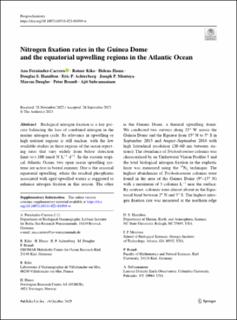| dc.description.abstract | Biological nitrogen fixation is a key process balancing the loss of combined nitrogen in the marine nitrogen cycle. Its relevance in upwelling or high nutrient regions is still unclear, with the few available studies in these regions of the ocean reporting rates that vary widely from below detection limit to > 100 nmol N L−1 d−1. In the eastern tropical Atlantic Ocean, two open ocean upwelling systems are active in boreal summer. One is the seasonal equatorial upwelling, where the residual phosphorus associated with aged upwelled waters is suggested to enhance nitrogen fixation in this season. The other is the Guinea Dome, a thermal upwelling dome. We conducted two surveys along 23° W across the Guinea Dome and the Equator from 15° N to 5° S in September 2015 and August–September 2016 with high latitudinal resolution (20–60 nm between stations). The abundance of Trichodesmium colonies was characterized by an Underwater Vision Profiler 5 and the total biological nitrogen fixation in the euphotic layer was measured using the 15N2 technique. The highest abundances of Trichodesmium colonies were found in the area of the Guinea Dome (9°–15° N) with a maximum of 3 colonies L−1 near the surface. By contrast, colonies were almost absent in the Equatorial band between 2° N and 5° S. The highest nitrogen fixation rate was measured at the northern edge of the Guinea Dome in 2016 (ca. 31 nmol N L−1 d−1). In this region, where diazotrophs thrived on a sufficient supply of both phosphorus and iron, a patchy distribution was unveiled by our increased spatial resolution scheme. In the Equatorial band, rates were considerably lower, ranging from below detection limit to ca. 4 nmol N L−1 d−1, with a clear difference in magnitude between 2015 (rates close to zero) and 2016 (average rates around 2 nmol N L−1 d−1). This difference seemed triggered by a contrasting supply of phosphorus between years. Our study stresses the importance of surveys with sampling at fine-scale spatial resolution, and shows unexpected high variability in the rates of nitrogen fixation in the Guinea Dome, a region where diazotrophy is a significant process supplying new nitrogen into the euphotic layer. | en_US |

